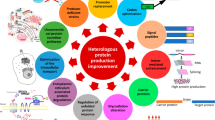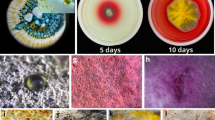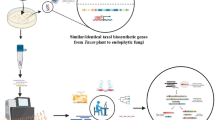Abstract
The gene encoding the precusor of a small secretory protein with antifungal activity was isolated from A. giganteus and characterized by restriction mapping, hybridization and nucleotide sequencing. The promoter contains a typical TATA-box at a distance of 135 bp upstream of the open reading frame. The open reading frame is interrupted by two small introns with conserved splice sites. The precursor of the antifungal protein (AFP) consists of 94 amino acids and appears to be processed to the mature AFP of 51 amino acids by a two-step process. Transfer of the gene into A. niger yielded only transformants with a very low expression level, probably because high-expression transformants were counterselected by the antifungal activity of the recombinant protein.
Similar content being viewed by others
References
Ballance DJ (1991) Transformation systems for filamentous fungi and an overview of fungal gene structure. In: Leong SA, Berka RM (eds) Molecular industrial mycology. Marcel Dekker, New York, pp 1–29
Bohlmann H, Clausen S, Behnke S, Giese H, Hiller C, Reimann-Philipp U, Schrader G, Barkholt V, Apel K (1988) Leaf-specific thionins of barley — a novel class of cell-wall proteins toxic to plant-pathogenic fungi and possibly involved in the defence mechanism of plants. EMBO J 7:1559–1565
Bostian KA, Eliott Q, Bussey H, Burn V, Smith A, Tipper DJ (1984) Sequence of the preprotoxin dsRNA gene of type-I killer yeast: multiple processing events produce a two-component toxin. Cell 36:741–751
Broekart WF, Van Parijs J, Leyns F, Joos H, Peumans WF (1989) A chitin-binding lectin from stinging nettle rhizomes with antifungal properties. Science 245:1100–1102
Gurr SJ, Unkles SE, Kinghorn JR (1987) The structure and organization of nuclear genes of filamentous fungi. In: Kinghorn JR (ed) Gene structure in eukaryotic microbes, Special publications of the Society for General Microbiology, vol 22. IRL Press, Oxford, pp 93–139
Heijne G von (1985) The limits of variation. J Mol Biol 184:99–105
Kozak M (1984) Compilation and anlysis of sequences upstream form the translational start site in eukaryotic mRNAs. Nucleic Acids Res 12:857–872
Nakaya N, Omata K, Okahashi I, Nakamura Y, Kolkenbrock HJ, Ulbrich N (1990) Amino-acid sequence and disulphide bridges of an antifungal-protein isolated from Aspergillus giganteus. Eur J Biochem 193:31–38
Olson BH, Goerner GL (1965) Alpha sarcin, a new antitumor agent. I. Isolation, purification, chemical composition, and the identify of a new amino acid. Appl Microbiol 13:314–321
Parijs J van, Broekart WF, Goldstein IJ, Peumans WJ (1991) Hevein: an antifungal protein from rubber-tree (Hevea brasiliensis) latex. Planta 183:258–264
Punt PJ, Oliver RP, Dingemanse MA, Pouwels PH, van den Hondel CAMJ J (1987) Transformation of Aspergillus based on a hygromycin B resistance marker from E. coli. Gene 56:117–124
Roberts WK, Seletrennikoff CP (1990) Zeamatin, an antifungal protein from maize with membrane-permeabilizing activity. J Gen Microbiol 136:1771–1778
Sambrook J, Fritsch EF, Maniatis T (1989) Molecular cloning: a laboratory manual, 2nd edn. Cold Spring Harbor Laboratory, Cold Spring Harbor, New York
Tao J, Ginsberg I, Banerjee N, Held W, Koltin Y, Bruenn J (1990) Ustilago maydis KP6 killer toxin: structure, expression in Saccharomyces cerevisiae, and relationship to other cellular protein. Mol Cell Biol 10:1373–1381
Terras FRG, Schoofs HME, De Bolle MFC, Van Leuven F, Rees SB, Vanderleyden J, Cammue BPA, Broekart WF (1992) Analysis of two novel classes of plant antifungal proteins from radish (Raphanus sativus L.) seeds. J Biol Chem 267:15301–15309
Wnendt S, Ulbrich N, Stahl U (1990) Cloning and nucleotide sequence of a cDNA encoding the antifungal-protein of Aspergillus giganteus and preliminary characterization of the native gene. Nucleic Acids Res 18:1653
Wnendt S, Felske-Zech H, Henze P-PC, Ulbrich N, Stahl U (1993) Characterization of the gene encoding α-sarcin, a ribosome-inactivating protein secreted by Aspergillus giganteus. Gene 124:239–244
Yelton MM, Hamer JE, Timberlake WE (1984) Transformation of Aspergillus nidulans by using a trpC plasmid. Proc Natl Acad Sci USA 81:1470–1474
Author information
Authors and Affiliations
Additional information
Communicated by K. Wolf
Rights and permissions
About this article
Cite this article
Wnendt, S., Ulbrich, N. & Stahl, U. Molecular cloning, sequence analysis and expression of the gene encoding an antifungal-protein from Aspergillus giganteus . Curr Genet 25, 519–523 (1994). https://doi.org/10.1007/BF00351672
Received:
Issue Date:
DOI: https://doi.org/10.1007/BF00351672




